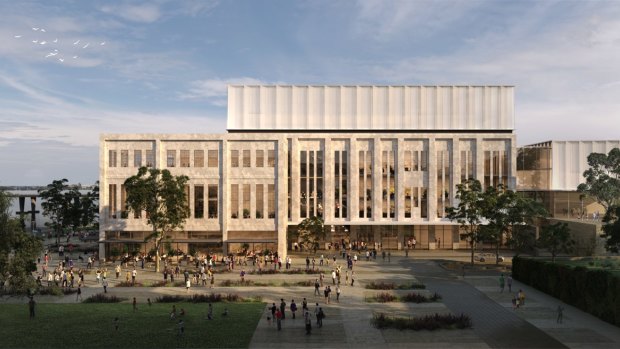This was published 3 years ago
McGowan defends $1 price tag for East Perth power station despite Landgate analysis
Premier Mark McGowan has defended a controversial deal with two of the state’s wealthiest businessmen that could see the East Perth power station land sold for just $1.
Works at the derelict site could begin as early as next year but details of negotiations between the government and billionaires Kerry Stokes and Andrew Forrest remain shrouded in secrecy.

An artist’s impression of the East Perth power station redevelopment.
Speaking to 6PR’s Liam Bartlett on Wednesday, Mr McGowan said the $1 valuation hadn’t been committed to, but would not reveal how much the businessmen would fork out for the site.
“This is a matter for negotiation between the government and the successful tenders,” he said. “The block hasn’t been sold, there is no value of a lease because we haven’t signed a lease.”
WAtoday revealed last May the land at the centre of the $218 million project had been valued by the government at just $1, despite being more than 8.5 hectares of prime waterfront real estate.
However, the latest unimproved value assessment by the government’s land authority, Landgate, suggested three of the four blocks within the precinct were worth a combined $26 million.
While unimproved land values are used for tax purposes only and don’t take into account contamination or improvement works, they give an indication of what the land would be expected to sell for in its current condition.
Environment Minister Stephen Dawson, who represents lands minister Ben Wyatt in the upper house, revealed under questioning from the opposition the four lots that made up the project precinct were worth $1, according to a valuation commissioned by the government.
This was because the cost of removing and relocating the power infrastructure on the site and subsequent decontamination would cost more than the value of the land itself.
Mr Stokes’ Australian Capital Equity and Dr Forrest’s Tattarang Pty Ltd – the Minderoo Group’s new name – were last year named as the preferred proponents to turn the 105-year-old landmark into a commercial and residential precinct.
The government initially planned to contribute $50 million towards site works but it was later revealed taxpayers would foot an extra $16.1 million towards the project, bringing the state’s contribution up to $66 million.
That means there is now more money budgeted by the McGowan government for the development than for a new museum at the same site planned by the Carpenter government before it lost office in 2008.

A redevelopment of the East Perth Power Station is slated to cost $218 million.
A government spokeswoman said the money would go towards moving the transmission line at the site and decommissioning the switch yard.
Mr McGowan defended the spending on air, saying it was common practice for governments across the country to carry out preparation works on a site before private developers moved in.
“Government has to spend that money in order to get the development up, otherwise you’ll have ruins sitting there, buildings that deteriorate and are dangerous,” he said.
“We are doing that with the Ocean Reef Marina, the Middleton Beach Hotel in Albany. It happens all over the state through Development WA, that’s what they do.
“The alternative is that you leave the site there for another 40 years.”
There have been repeated calls over the past six years for the development of a landmark scientific or cultural precinct in East Perth, with the old power station site as the centrepiece, and for it to be supported by government leadership and funding at state and federal levels.
In 2015, the space was stabilised with some basic works and the Metropolitan Redevelopment Authority called for expressions of interest to develop it.
Five applicants were shortlisted but never revealed.
Also in 2015, an international art foundation approached architecture firm Hassell to find a location for a new cultural building. Hassell proposed a contemporary gallery connecting with the old power station at its northern end to maintain the historic riverfront presence.
The concept plan won a 2016 Chicago Athenaeum International Architecture Award but nothing happened, in major part due to a lack of support, leadership or financial buy-in from government agencies.
Four years later, Perth MP Patrick Gorman took up the fight after his surveyed constituents showed overwhelming support for the redevelopment of the site.
Finally, in April 2020, the government announced Mr Stokes and Mr Forrest’s companies as preferred joint proponents for a $218 million commercial, residential and dining development.
Mr McGowan said negotiations would take place over the course of 2021, with construction to kick off early next year if an agreement was reached. The project would not be completed until 2025.
with Emma Young